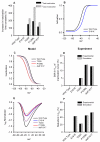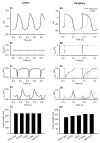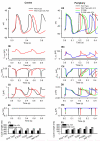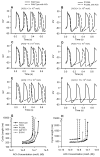Mechanistic links between Na+ channel (SCN5A) mutations and impaired cardiac pacemaking in sick sinus syndrome
- PMID: 20448214
- PMCID: PMC2901593
- DOI: 10.1161/CIRCRESAHA.110.219949
Mechanistic links between Na+ channel (SCN5A) mutations and impaired cardiac pacemaking in sick sinus syndrome
Abstract
Rationale: Familial sick sinus syndrome (SSS) has been linked to loss-of-function mutations of the SCN5A gene, which result in decreased inward Na(+) current, I(Na). However, the functional role of I(Na) in cardiac pacemaking is controversial, and mechanistic links between mutations and sinus node dysfunction in SSS are unclear.
Objective: To determine mechanisms by which the SCN5A mutations impair cardiac pacemaking.
Methods and results: Action potential (AP) models for rabbit sinoatrial node (SAN) cells were modified to incorporate experimentally reported I(Na) changes induced by 2 groups of SCN5A gene mutations (affecting the activation and inactivation of I(Na), respectively). The cell models were incorporated into an anatomically detailed 2D model of the intact SAN-atrium. Effects of the mutations and vagal nerve activity on cardiac pacemaking at the single-cell and tissue levels were studied. Multielectrode extracellular potential recordings of activation pattern from intact SAN-atrium preparations were performed to test predictions of the models. At the single-cell level, the mutations slowed down pacemaking rates in peripheral, but not in central SAN cells that control the heart rhythm. However, in tissue simulations, the mutations not only slowed down pacemaking, but also compromised AP conduction across the SAN-atrium, leading to a possible SAN exit block or sinus arrest, the major features of SSS. Simulated vagal nerve activity amplified the bradycardiac effects of the mutations. Two groups of SCN5A mutations showed subtle differences in impairing the ability of the SAN to drive the surrounding atrium, primarily attributable to their differential effects on atrial excitability and conduction safety. Experimental data with tetrodotoxin and carbachol confirmed the simulation outcomes.
Conclusions: Our study substantiates the causative link between SCN5A gene mutations and SSS and illustrates mechanisms by which the mutations impair the driving ability of the SAN.
Figures













Similar articles
-
Altered sinoatrial node function and intra-atrial conduction in murine gain-of-function Scn5a+/ΔKPQ hearts suggest an overlap syndrome.Am J Physiol Heart Circ Physiol. 2012 Apr 1;302(7):H1510-23. doi: 10.1152/ajpheart.00357.2011. Epub 2012 Jan 27. Am J Physiol Heart Circ Physiol. 2012. PMID: 22287583 Free PMC article.
-
TGF-β1-mediated fibrosis and ion channel remodeling are key mechanisms in producing the sinus node dysfunction associated with SCN5A deficiency and aging.Circ Arrhythm Electrophysiol. 2011 Jun;4(3):397-406. doi: 10.1161/CIRCEP.110.960807. Epub 2011 Apr 14. Circ Arrhythm Electrophysiol. 2011. PMID: 21493874
-
Sinus node dysfunction following targeted disruption of the murine cardiac sodium channel gene Scn5a.J Physiol. 2005 Sep 1;567(Pt 2):387-400. doi: 10.1113/jphysiol.2005.083188. Epub 2005 Jun 2. J Physiol. 2005. PMID: 15932895 Free PMC article.
-
Genetic Na+ channelopathies and sinus node dysfunction.Prog Biophys Mol Biol. 2008 Oct-Nov;98(2-3):171-8. doi: 10.1016/j.pbiomolbio.2008.10.003. Epub 2008 Nov 5. Prog Biophys Mol Biol. 2008. PMID: 19027778 Review.
-
SCN5A and sinoatrial node pacemaker function.Cardiovasc Res. 2007 Jun 1;74(3):356-65. doi: 10.1016/j.cardiores.2007.01.009. Epub 2007 Jan 19. Cardiovasc Res. 2007. PMID: 17368591 Review.
Cited by
-
The genetic basis for inherited forms of sinoatrial dysfunction and atrioventricular node dysfunction.J Interv Card Electrophysiol. 2015 Aug;43(2):121-34. doi: 10.1007/s10840-015-9998-z. Epub 2015 Apr 12. J Interv Card Electrophysiol. 2015. PMID: 25863800 Free PMC article. Review.
-
Genetic Complexity of Sinoatrial Node Dysfunction.Front Genet. 2021 Apr 1;12:654925. doi: 10.3389/fgene.2021.654925. eCollection 2021. Front Genet. 2021. PMID: 33868385 Free PMC article. Review.
-
Transient Notch Activation Induces Long-Term Gene Expression Changes Leading to Sick Sinus Syndrome in Mice.Circ Res. 2017 Aug 18;121(5):549-563. doi: 10.1161/CIRCRESAHA.116.310396. Epub 2017 Jul 3. Circ Res. 2017. PMID: 28674041 Free PMC article.
-
A Heart for Diversity: Simulating Variability in Cardiac Arrhythmia Research.Front Physiol. 2018 Jul 20;9:958. doi: 10.3389/fphys.2018.00958. eCollection 2018. Front Physiol. 2018. PMID: 30079031 Free PMC article. Review.
-
Mechanistic insight into the functional role of human sinoatrial node conduction pathways and pacemaker compartments heterogeneity: A computer model analysis.PLoS Comput Biol. 2023 Dec 18;19(12):e1011708. doi: 10.1371/journal.pcbi.1011708. eCollection 2023 Dec. PLoS Comput Biol. 2023. PMID: 38109436 Free PMC article.
References
-
- Adan V, Crown LA. Diagnosis and treatment of sick sinus syndrome. Am Fam Physician. 2003;67:1725–1732. - PubMed
-
- Dobrzynski H, Boyett MR, Anderson RH. New insights into pacemaker activity: Promoting understanding of sick sinus syndrome. Circulation. 2007;115:1921–1932. - PubMed
-
- Alboni P, Gianfranchi L, Brignole M. Treatment of persistent sinus bradycardia with intermittent symptoms: are guidelines clear? Europace. 2009 (doi:10.1093/europace/eup014) - PubMed
Publication types
MeSH terms
Substances
Grants and funding
LinkOut - more resources
Full Text Sources
Medical
Miscellaneous

